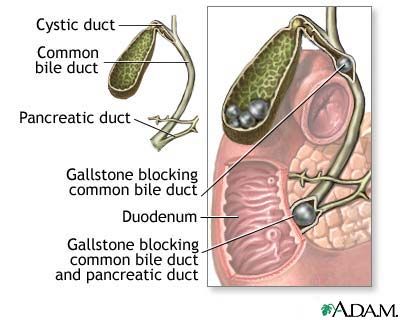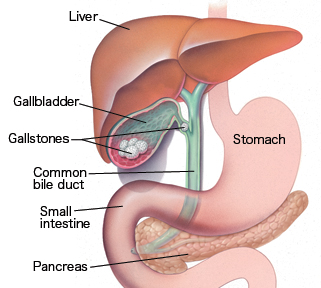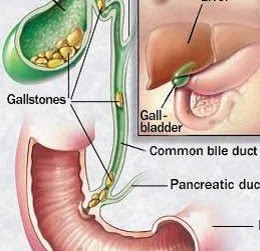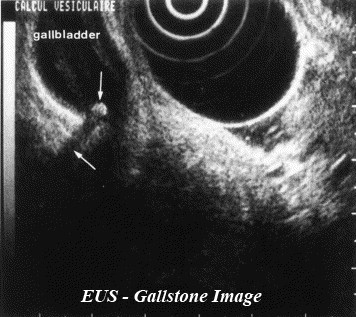Gallstones

What are gallstones?
Gallstones form when liquid stored in the gallbladder hardens into pieces of stone-like material. The liquid, called bile, is used to help the body digest fats. Bile is made in the liver, then stored in the gallbladder until the body needs to digest fat. At that time, the gallbladder contracts and pushes the bile into a tube—called the common bile duct—that carries it to the small intestine, where it helps with digestion.
Bile contains water, cholesterol, fats, bile salts, proteins, and bilirubin.
Bile salts break up fat, and bilirubin gives bile and stool a yellowish color. If the liquid bile contains too much cholesterol, bile salts, or bilirubin, under certain conditions it can harden into stones.
The two types of gallstones are cholesterol stones and pigment stones. Cholesterol stones are usually yellow-green and are made primarily of hardened cholesterol. They account for about 80 percent of gallstones.
Pigment stones are small, dark stones made of bilirubin.
Gallstones can be as small as a grain of sand or as large as a golf ball. The gallbladder can develop just one large stone, hundreds of tiny stones, or almost any combination.
Gallstones can block the normal flow of bile if they lodge in any of the ducts that carry bile from the liver to the small intestine. That includes the hepatic ducts, which carry bile out of the liver; the cystic duct, which takes bile to and from the gallbladder; and the common bile duct, which takes bile from the cystic and hepatic ducts to the small intestine.
Bile trapped in these ducts can cause inflammation in the gallbladder, the ducts, or, rarely, the liver.
Other ducts open into the common bile duct, including the pancreatic duct, which carries digestive enzymes out of the pancreas. If a gallstone blocks the opening to that duct, digestive enzymes can become trapped in the pancreas and cause an extremely painful inflammation called gallstone pancreatitis.
If any of these ducts remain blocked for a significant period of time, severe—possibly fatal—damage or infections affecting the gallbladder, liver, or pancreas can occur.
Warning signs of a serious problem are fever, jaundice, and persistent pain.
 What causes gallstones?
What causes gallstones?
Cholesterol Stones
Scientists believe cholesterol stones form when bile contains too much cholesterol, too much bilirubin, or not enough bile salts, or when the gallbladder does not empty as it should for some other reason.
Pigment Stones
The cause of pigment stones is uncertain. They tend to develop in people who have cirrhosis, biliary tract infections, and hereditary blood disorders, such as sickle cell anemia, in which too much bilirubin is formed.
Other Factors
It is believed that the mere presence of gallstones may cause more gallstones to develop. However, other factors that contribute to gallstones have been identified, especially for cholesterol stones.
Obesity
Obesity is a major risk factor for gallstones, especially in women. A large clinical study showed that being even moderately overweight increases the risk for developing gallstones. The most likely reason is that obesity tends to reduce the amount of bile salts in bile, resulting in more cholesterol. Obesity also decreases gallbladder emptying.
Estrogen.
Excess estrogen from pregnancy, hormone replacement therapy, or birth control pills appears to increase cholesterol levels in bile and decrease gallbladder movement, both of which can lead to gallstones.
Ethnicity.
Native Americans have a genetic predisposition to secrete high levels of cholesterol in bile. In fact, they have the highest rate of gallstones in the United States. A majority of Native American men have gallstones by age 60. Among the Pima Indians of Arizona, 70 percent of women have gallstones by age 30. Mexican American men and women of all ages also have high rates of gallstones.
Gender.
Women between 20 and 60 years of age are twice as likely to develop gallstones as men.
Age. People over age 60 are more likely to develop gallstones than younger people.
Cholesterol-lowering drugs. Drugs that lower cholesterol levels in blood actually increase the amount of cholesterol secreted in bile. This in turn can increase the risk of gallstones.
Diabetes. People with diabetes generally have high levels of fatty acids called triglycerides. These fatty acids increase the risk of gallstones.
Rapid weight loss.
As the body metabolizes fat during rapid weight loss, it causes the liver to secrete extra cholesterol into bile, which can cause gallstones.
Fasting.
Fasting decreases gallbladder movement, causing the bile to become overconcentrated with cholesterol, which can lead to gallstones.
 Who is at risk for gallstones?
Who is at risk for gallstones?
women
people over age 60
Native Americans
Mexican Americans
overweight
men and women
people who fast or lose a lot of weight
quickly
pregnant women,
women on hormone replacement therapy,
and women who use birth control pills
What are the symptoms?
Symptoms of gallstones are often called a gallstone "attack" because they occur suddenly.
A typical attack can cause
steady pain in the upper abdomen that increases rapidly and lasts from 30 minutes to several hours
pain in the back between the shoulder blades
pain under the right shoulder
nausea or vomiting
Gallstone attacks often follow fatty meals, and they may occur during the night. Other gallstone symptoms include
abdominal bloating
recurring intolerance of fatty foods
colic
belching
gas
indigestion
People who also have the above and any of following symptoms should see a doctor right away:
chills
low-grade fever
yellowish color of the skin or whites of the eyes
clay-colored stools
Many people with gallstones have no symptoms.
These patients are said to be asymptomatic, and these stones are called "silent stones." They do not interfere with gallbladder, liver, or pancreas function, and do not need treatment.
How are gallstones diagnosed?
Many gallstones, especially silent stones, are discovered by accident during tests for other problems. But when gallstones are suspected to be the cause of symptoms, the doctor is likely to do an ultrasound exam.
 Ultrasound uses sound waves to create images of organs.
Ultrasound uses sound waves to create images of organs.
Sound waves are sent toward the gallbladder through a handheld device that a technician glides over the abdomen. The sound waves bounce off the gallbladder, liver, and other organs such as a pregnant uterus, and their echoes make electrical impulses that create a picture of the organ on a video monitor. If stones are present, the sound waves will bounce off them, too, showing their location.
Ultrasound is the most sensitive and specific test for gallstones.
Endoscopic ultrasounds EUS: is a minimally invasive procedure with a procedural risk identical to that of gastroscopy (OGD) with low morbidity . The close proximity of the echoendoscope to the extra hepatic bile ductal system, lack of radiation and safety makes EUS an excellent method for examining the common bile duct and gallbladder such that small stones, biliary sludge, and even micro-lithiasis can be demonstrated.
Other tests may also be used.
Computed tomography (CT) scan may show the gallstones or complications.
Magnetic resonance cholangiogram may diagnose blocked bile ducts.
Cholescintigraphy (HIDA scan) is used to diagnose abnormal contraction of the gallbladder or obstruction.
The patient is injected with a radioactive material that is taken up in the gallbladder, which is then stimulated to contract.
Endoscopic retrograde cholangiopancreatography (ERCP). The patient swallows an endoscope—a long, flexible, lighted tube connected to a computer and TV monitor.
The doctor guides the endoscope through the stomach and into the small intestine.
The doctor then injects a special dye that temporarily stains the ducts in the biliary system.
ERCP is used to locate and remove stones in the ducts.
Blood tests.
Blood tests may be used to look for signs of infection, obstruction, pancreatitis, or jaundice.
Gallstone symptoms are similar to those of heart attack,
appendicitis,
ulcers,
irritable bowel syndrome,
hiatal hernia,
pancreatitis, and hepatitis.
So accurate diagnosis is important.
What is the treatment?
Surgery
Surgery to remove the gallbladder is the most common way to treat symptomatic gallstones. (Asymptomatic gallstones usually do not need treatment.) Each year more than 500,000 Americans have gallbladder surgery. The surgery is called cholecystectomy.
The most common operation is called laparoscopic cholecystectomy.
For this operation, the surgeon makes several tiny incisions in the abdomen and inserts surgical instruments and a miniature video camera into the abdomen. The camera sends a magnified image from inside the body to a video monitor, giving the surgeon a closeup view of the organs and tissues.
While watching the monitor, the surgeon uses the instruments to carefully separate the gallbladder from the liver, ducts, and other structures.
Then the cystic duct is cut and the gallbladder removed through one of the small incisions.
Because the abdominal muscles are not cut during laparoscopic surgery, patients have less pain and fewer complications than they would have had after surgery using a large incision across the abdomen. Recovery usually involves only one night in the hospital, followed by several days of restricted activity at home.
If the surgeon discovers any obstacles to the laparoscopic procedure, such as infection or scarring from other operations, the operating team may have to switch to open surgery. In some cases the obstacles are known before surgery, and an open surgery is planned. It is called "open" surgery because the surgeon has to make a 5- to 8-inch incision in the abdomen to remove the gallbladder.
This is a major surgery and may require about a 2- to 7-day stay in the hospital and several more weeks at home to recover.
Open surgery is required in about 5 percent of gallbladder operations.
The most common complication in gallbladder surgery is injury to the bile ducts. An injured common bile duct can leak bile and cause a painful and potentially dangerous infection. Mild injuries can sometimes be treated nonsurgically. Major injury, however, is more serious and requires additional surgery.
If gallstones are in the bile ducts, the physician (usually a gastroenterologist) may use endoscopic retrograde cholangiopancreatography (ERCP) to locate and remove them before or during the gallbladder surgery.
In ERCP, the patient swallows an endoscope—a long, flexible, lighted tube connected to a computer and TV monitor. The doctor guides the endoscope through the stomach and into the small intestine. The doctor then injects a special dye that temporarily stains the ducts in the biliary system. Then the affected bile duct is located and an instrument on the endoscope is used to cut the duct. The stone is captured in a tiny basket and removed with the endoscope.
Occasionally, a person who has had a cholecystectomy is diagnosed with a gallstone in the bile ducts weeks, months, or even years after the surgery. The two-step ERCP procedure is usually successful in removing the stone.
Nonsurgical Treatment
Nonsurgical approaches are used only in special situations—such as when a patient has a serious medical condition preventing surgery—and only for cholesterol stones. Stones usually recur after nonsurgical treatment.
- Oral dissolution therapy.
Drugs made from bile acid are used to dissolve the stones. The drugs, ursodiol (Actigall) and chenodiol (Chenix), work best for small cholesterol stones. Months or years of treatment may be necessary before all the stones dissolve. Both drugs cause mild diarrhea, and chenodiol may temporarily raise levels of blood cholesterol and the liver enzyme transaminase. - Contact dissolution therapy.
This experimental procedure involves injecting a drug directly into the gallbladder to dissolve stones. The drug—methyl tertbutyl ether—can dissolve some stones in 1 to 3 days, but it must be used very carefully because it is a flammable anesthetic that can be toxic. The procedure is being tested in patients with symptomatic, noncalcified cholesterol stones.
Don't people need their gallbladder?
Fortunately, the gallbladder is an organ that people can live without. Losing it won't even require a change in diet. Once the gallbladder is removed, bile flows out of the liver through the hepatic ducts into the common bile duct and goes directly into the small intestine, instead of being stored in the gallbladder. However, because the bile isn't stored in the gallbladder, it flows into the small intestine more frequently, causing diarrhea in about 1 percent of people.

